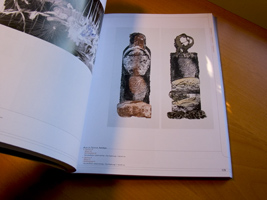exhibiting in Hungary

Many printmakers around the world have developed a strong sense of community that is enhanced in part by their participation in some of the many international juried print biennials and triennials.
One of the best and largest is the Krakow Print Triennial held in Poland. They do a tremendous amount of work, from selecting by jury from hundreds of art works submitted by artists from around the world, and organizing the many exhibitions in numerous venues, including travel to other cities and countries. A very good catalogue is published and given to each participating artist.
The photo is showing my two prints Nexus IX and Nexus X as printed in the 2003 Triennial catalogue. Canada did very well with 19 artists taking part and especially with the Grand Prix being awarded to Canadian Davida Kidd.
As I mentioned a year ago, the main triennial show which included my work travelled to Oldenburg, Germany. Recently I learned that this exhibition continued on to Gyor, Hungary for November-December 2004. Now it is in Budapest in several venues. I think my prints have been seeing more of the world than I have!
Unfortunately the Krakow Print Triennial’s website has been undergoing a total reconstruction and most of my previous links in the older posts are now broken, and I will have to go back for some repair work when they have finished. I do hope they will bring back much of the excellent material they had about the past triennials.





